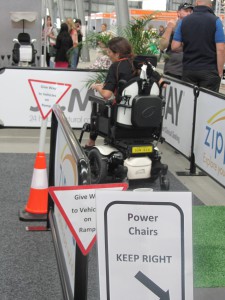Changes are ahead for suppliers and owners of motorised mobility devices (MMD). Speaking at the Daily Living Expo in Melbourne, Queensland University of Technology researcher, Ian Faulks, said Draft recommendations expected to be formally agreed nationally by mid-2015 are likely to include:
1: All MMDs must carry a compliance label or sticker at point of purchase – no registration will be required. MMDs can be on-sold or transferred, and remain legal for use on footpaths and roads as long as it carries this certification. This is designed to reduce impact on manufacturers and suppliers.
2: For use on footpaths and roads, an MMD must have been constructed to comply with a Vehicle Standards Bulletin, or VSB. The Australian Road Rules will reference the VSB, and the VSB in turn will relate to the Australian Standard for Electric Wheelchairs AS/NZS 3695.2 [2013] and to the national disability access standard. Again, this means harmonisation, no duplication and is designed to reduce impact on manufacturers and suppliers.
3: Certificate of rider competency requirement is still being decided as there is a difference of opinion on this recommendation.
4: That the MMDs may only be used by one rider: and that is a person who has difficulty walking. Tandem MMDs will not be allowed on footpaths, roads and other pedestrian infrastructure.
Faulks also discussed a number of wide ranging issues associated with the use of MMDs. He said the number of MMDs is doubling every five years and many do not comply with current regulations when it comes to un-laden weight and maximum speeds. Of particular concern were the number of fatalities and injuries occurring. According to the most recent data available there were six deaths and 350 injuries in 2009 carrying an estimated cost to the community of $90 million. With around 80,000 on the footpath in 2009, the average accident risk and cost amounts to $1000 per scooter, Faulks said. “MMDs do not travel very far and usually move at low speed, so these safety issues are surprising.”
As for assessment of those using the devices, for now this has been placed on the back burner, but the proposal for the road transport law relating to MMDs is that they must be used by people who cannot walk or who have difficulty in walking. “At this point, we are more concerned with getting the devices compliant.”
Another unresolved issue relates to safe speeds and Faulks’ view is that the maximum speed should be no more than 10kph on an open footpath, and not more than 5kph when there is dense pedestrian traffic. This means a “tortoise mode” button to limit speed when moving in a crowd. “MMDs are for people who can’t walk, so they should be thought of as pedestrian assist devices, not some footpath version of a car.”

